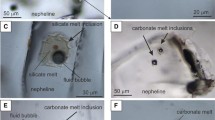Abstract
The authors have studied melt-fluid and fluid inclusions in quartz and fluorite of sideritic and ankerite-calcitic carbonatites of the Karasug ore field, as well as melt inclusions in apatite from granosyenites. The content of salt and fluid components in brine-melt inclusions was evaluated on the basis of the thermodynamic data, the calculations of volumes and densities of the solid phases, a solution of about 50% concentration, and the gas phase of the inclusions, as well as the results of the LA-ICP-MS analysis. The content of salt phases, the solution, and the gas phase amounted to 85–70, 10–25, and about 5% of the inclusion substance, respectively. The total percentage of salt and fluid components (H2O and CO2) amounted to 90–80 and 10–20 wt %, respectively. The fraction of a carbonate constituent in the inclusions was as high as 45–50% and over in ankerite-calcite carbonatites and about 15 wt % in sideritic carbonatites. The 117.2 ± 1.3 Ma age of these carbonatites by 40Ar/39Ar, along with other datings for this area, shows that their formation was associated with a manifestation of the Cretaceous alkaline-mafic magmatism (117–120 Ma). The presented model of the formation of carbonatites is in agreement with the sequence of the development of magmatic processes and mineralization in this area. The model is also confirmed by the results of the studies of melt and fluid inclusions in minerals.
Similar content being viewed by others
References
D. O. Ontoev, Geology of Complex Rare-Earth Deposits (Nedra, Moscow, 1984) [in Russian].
A. V. Bolonin, A. V. Nikiforov, D. A. Lykhin, and A. M. Sugorakova, Geology of Ore Deposits 51(1), 33 (2009).
E. B. Sal’nikova, S. Z. Yakovleva, A. B. Kotov, et al., Doklady Earth Sciences 430(1), 134 (2010).
A. V. Nikiforov, A. V. Bolonin, B. G. Pokrovskii, et al., Geology of Ore Deposits 48(4), 256 (2006).
A. S. Borisenko, A. A. Borovikov, E. A. Vasyukova, et al., Geol. Geofiz. 52(1), 182–206 (2011).
S. A. Bredikhina and S. V. Mel’gunov, Geol. Geofiz., No. 10, 61–68 (1989).
E. A. Vasyukova, A. E. Izokh, A. S. Borisenko, et al., Geol. Geofiz. 52(12), 2001–2021 (2011).
Author information
Authors and Affiliations
Corresponding author
Additional information
Original Russian Text © I.R. Prokop’ev, A.A. Borovikov, G.G. Pavlova, A.S. Borisenko, 2014, published in Doklady Akademii Nauk, 2014, Vol. 455, No. 5, pp. 572–575.
Rights and permissions
About this article
Cite this article
Prokop’ev, I.R., Borovikov, A.A., Pavlova, G.G. et al. The role of chloride-carbonate melts in the formation of sideritic carbonatites of the KARASUg FE-F-REE deposit (Tyva Republic, Russia). Dokl. Earth Sc. 455, 446–449 (2014). https://doi.org/10.1134/S1028334X14050092
Received:
Published:
Issue Date:
DOI: https://doi.org/10.1134/S1028334X14050092




